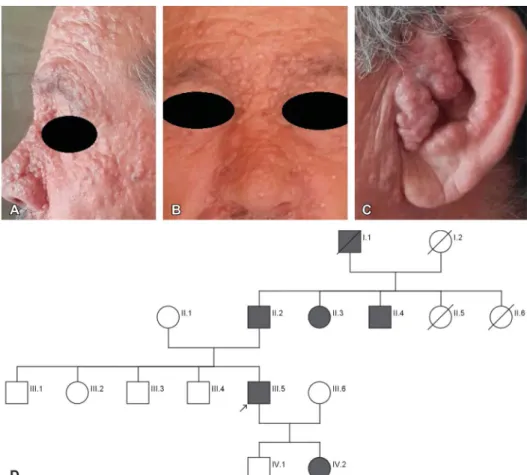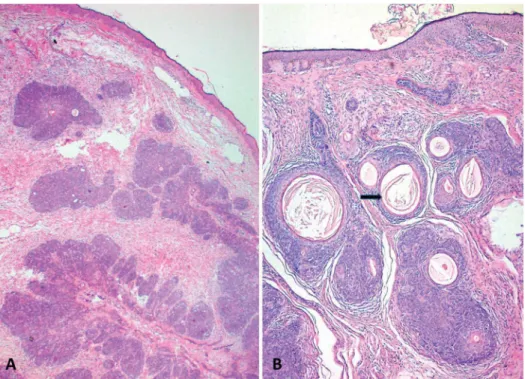L
ETTERS TO THEE
DITORBrooke–Spiegler Syn- drome: Two Patients From a Turkish Family With Multiple Familial
Trichoepithelioma
To the Editor:
Brooke–Spiegler syndrome (BSS) is a rare hereditary autosomal dominant disease. It is characterized by multiple benign skin appendageal tu- mors such as cylindromas, trichoepi- theliomas, and spiradenomas. Familial cylindromatosis (FC) and multiple familial trichoepithelioma (MFT) are
phenotypic variants of BSS. FC is characterized by cylindromas and MFT by trichoepitheliomas as the only tumor type. The cylindromatosis gene (CYLD) is the causative gene responsible for the development of BSS and its phenotypic variants. The CYLD is a tumor sup- pressor gene that plays a key role on regulation of NF-kB signaling path- way.1In this study, we present 2 cases in a Turkish family with MFT carrying the CYLDmutation and aim to discuss with the literature.
The case of 53-year-old male patient was referred to our clinic by the Plastic Surgery Department. The patient had a 25-year long history of multiple lesions on his face, which appeared in adolescence and slowly had been grow-
ing in sizes and numbers during the following years. Clinical examination showed the patient had numerous pap- ules and nodules with ranging in size from 1 · 1 to 2 · 2 cm on the face mostly around the nose, periorbital area, and ears (Fig. 1). To date, results of all biopsies have supported the diagnosis of trichoepithelioma. In addition, basal cell carcinoma (BCC) has been determined in the last 2 histopathological examina- tions (Figs. 2 and 3).
The 19-year-old daughter of the proband also presented similar lesions but were fewer in number on her fore- head, nasolabial, postauricular, and occipital regions. Her nodular and pap- ular lesions began 8 years ago and most of them had been removed for esthetical
FIGURE 1. Clinical data of family with BSS. A–C, Multiple papules on the proband’s face, mostly around the nose, periorbital area, and ears. D, Pedigree of the family.
The authors declare no conflicts of interest.
Am J Dermatopathol Volume 00, Number 00, Month 2018 www.amjdermatopathology.com |
1
Copyright 2018 Wolters Kluwer Health, Inc. Unauthorized reproduction of this article is prohibited.
reasons. Histopathological examinations of the lesions revealed trichoepithelio- ma. Pedigree analysis of the family is consistent and an autosomal dominant inheritance (Fig. 1).
The genetic investigations were conducted on the peripheral blood sam- ples of the patients. From the blood sample, genomic DNA was isolated and the coding regions, and the flanking
introns of theCYLDgene were amplified with specific primers. The polymerase chain reaction products were sequenced using ABI Prism 7000 sequencer.
Our investigations have been iden- tified a heterozygous nonsense mutation (c.2104delA, p.Ile702X) in the 15th exon of theCYLDgene in 2 patients. The pres- ence of the mutation leads to the formation of premature stop codon and thus to the synthesis of a truncatedCYLDprotein.
Until now, more than 90 muta- tions have been identified for theCYLD gene in individuals presented with the phenotypic characteristics of BSS, FC, and/or MFT in the literature. The most of reported CYLD mutations cause premature protein truncations. First, a germline CYLDmutation is inherited, and second, noninherited CYLD muta- tion or loss of heterozygosity occurs in cells for tumor formation in BSS.2,3
The c.2104delA, p.Ile702X muta- tion has been described only once in the mother and daughter by Sima et al.4Our patients had clinically and histopatholog- ically diagnosed MFT, whereas their pa- tients had multiple scalp tumors and histopathologically diagnosed cylindro- mas.4 The comparisons of mutations and clinical variations have revealed that FIGURE 2. Trichoepithelioma. A, Hematoxylin eosin·100. Nests of basaloid cells, some with abortive hair follicle differentiation.
B, Hematoxylin eosin·200. Another lesion of the same case. Basaloid lobules showing prominent keratocysts and infundibular keratinization (arrow) without epidermal continuity, retraction artifact, or stromal mucin.
FIGURE 3. Hematoxylin eosin·200. Basal cell carcinoma. Basaloid lobules showing peripheral palisading (white arrows) and retraction artifact (blue arrows) accompa- nied with stromal mucin (red arrows) and epidermal ulceration (black arrow).
Letters to the Editor Am J Dermatopathol Volume 00, Number 00, Month 2018
2
| www.amjdermatopathology.com Copyright © 2018 Wolters Kluwer Health, Inc. All rights reserved.Copyright 2018 Wolters Kluwer Health, Inc. Unauthorized reproduction of this article is prohibited.
the nonsense mutations are associated with the highest phenotypic diversity and recurrence rate, whereas missense mutations are associated with trichoepi- theliomas and a milder phenotype. But, a clear genotype–phenotype correlation is currently unknown.5,6
Also BCC has been determined in our patient. As far as we know, the BCC has been reported for the first time with c.2104delA, p.Ile702X mutation. Trichoe- pitheliomas are typically benign but rarely develops BCC in patients affected with MFT. However, CYLD is important in more common cancers such as colorectal, hepatocellular carcinoma, and melanoma.7 Consequently, our report supports the view that there is a lack of genotype–
phenotype correlation. In addition, the inability to establish genotype–
phenotype correlation suggests different changes such as secondary epigenetic events downstream besides the CYLD mutations. Further studies to confirm these arguments will be helpful in elu- cidating the mechanism leading to phe- notypic differences observed in patients
carrying the same mutations. Better understanding of the molecular mecha- nisms of CYLD and BSS may help to identify new treatment options. Fur- thermore, physicians should be aware of the potential for the development of BCC despite commonly benign clinical presentation. Long-term follow-up of the patients will be crucial to the early diag- nosis of malignancies.
Gunes Cakmak Genc, MD, PhD*
Ahmet Dursun, MD*
Nikoletta Nagy, MD† Ayca Celikmakas, MD*
Burcin Acuner, MD‡
*Department of Medical Genetics, Bülent Ecevit University Health Practice and Research Center, Zonguldak, Turkey
†Department of Medical Genetics, University of Szeged, Szeged, Hungary
‡Department of Plastic, Reconstructive and Aesthetic Surgery, Bülent Ecevit University Health Practice and Research Center, Zonguldak, Turkey
REFERENCES
1. Verhoeft KR, Ngan HL, Lui VWY. The cylin- dromatosis (CYLD) gene and head and neck tumorigenesis. Cancers Head Neck. 2016;1:
10. Review.
2. Lee DA, Grossman ME, Schneiderman P, et al.
Genetics of skin appendage neoplasms and related syndromes. J Med Genet. 2005;42:
811–819.
3. Bignell GR, Warren W, Seal S, et al. Identifi- cation of the familial cylindromatosis tumour- suppressor gene.Nat Genet.2000;25:160–165.
4. Sima R, Vanecek T, Kacerovska D, et al.
Brooke-Spiegler syndrome: report of 10 pa- tients from 8 families with novel germline mu- tations: evidence of diverse somatic mutations in the same patient regardless of tumor type.
Diagn Mol Pathol.2010;19:83–91.
5. Blake PW, Toro JR. Update of cylindromatosis gene (CYLD) mutations in Brooke-Spiegler syndrome: novel insights into the role of deu- biquitination in cell signaling. Hum Mutat.
2009;30:1025–1036. Review.
6. Nagy N, Farkas K, Kemény L et al. Phenotype- genotype correlations for clinical variants caused by CYLD mutations.Eur J Med Genet.
2015;58:271–278. Review.
7. Kazakov DV, Schaller J, Vanecek T, et al.
Brooke-Spiegler syndrome: report of a case with a novel mutation in the CYLD gene and different types of somatic mutations in benign and malignant tumors.J Cutan Pathol. 2010;
37:886–890.
Am J Dermatopathol Volume 00, Number 00, Month 2018 Letters to the Editor
Copyright © 2018 Wolters Kluwer Health, Inc. All rights reserved. www.amjdermatopathology.com |

